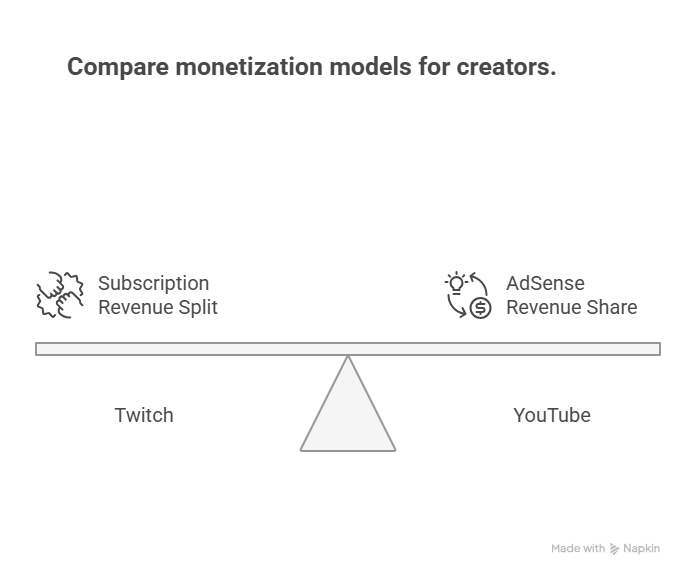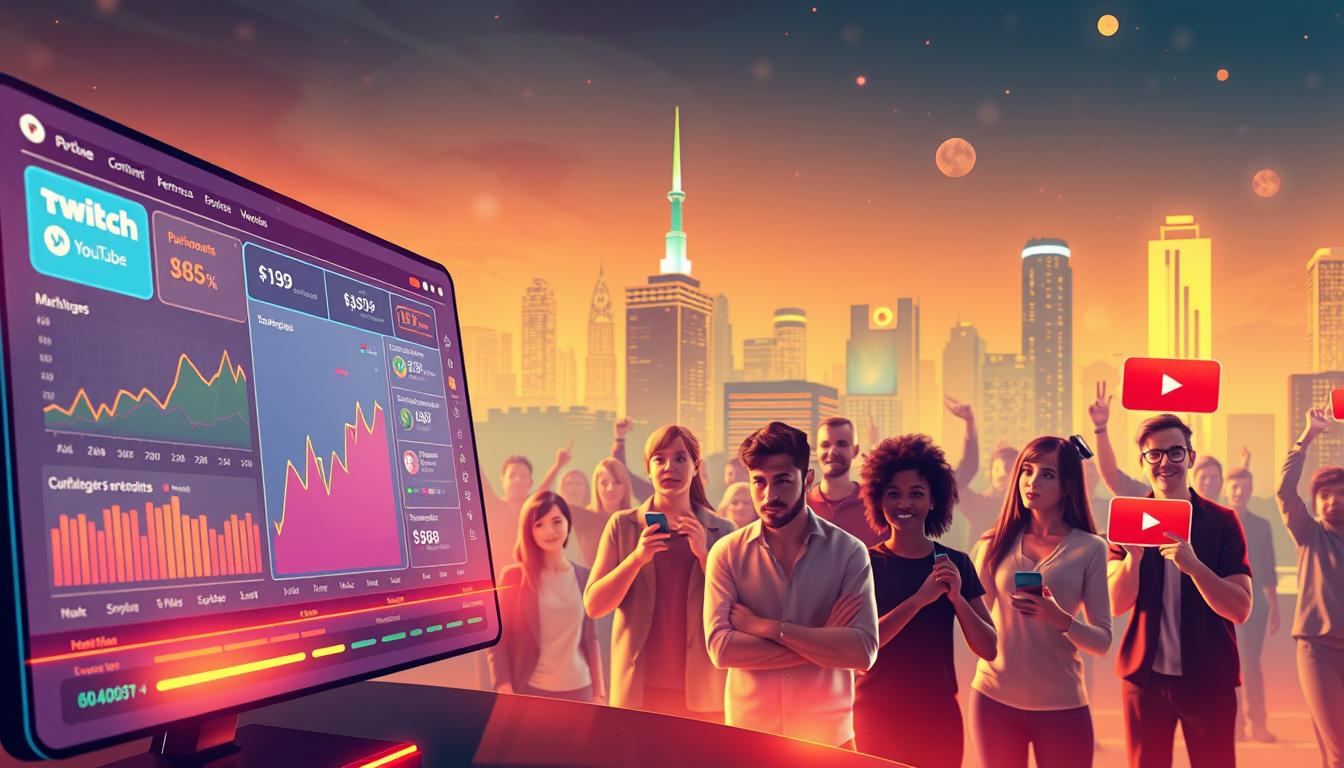As a content creator, choosing the right platform to monetize your content is crucial. With revenue potential for creators being a top priority, the debate between Twitch and YouTube continues to gain traction.
The rise of streaming platforms has opened up new avenues for creators to earn money. While both Twitch and YouTube offer various monetization options, the question remains: which platform pays more? In this article, we’ll delve into the details of twitch vs youtube for creators and explore the revenue potential of each platform.
By examining the key features and benefits of each platform, we’ll provide you with a comprehensive understanding of which platform is best suited for your content creation needs.
Monetization Models: Twitch vs YouTube for Creators
To determine which platform pays more, it’s essential to delve into the monetization options available on Twitch and YouTube. Both platforms offer unique revenue streams that cater to different types of creators and content.
Twitch Revenue Streams
Twitch provides several ways for streamers to earn money, primarily through community engagement and live streaming.
Subscriptions and Bits
On Twitch, subscriptions are a significant revenue source. Viewers can subscribe to their favorite channels for exclusive content, emotes, and other perks. Additionally, Bits are a virtual currency that viewers can use to cheer for streamers during live broadcasts, with streamers earning a share of the revenue generated from Bits.
Ads and Sponsorships
Twitch streamers can also earn money through ads displayed during their streams. While the revenue from ads can vary, it’s another way for creators to monetize their audience. Furthermore, sponsorships and partnerships with brands allow streamers to promote products or services, often providing a more lucrative income stream than ads alone.
YouTube Monetization Options
YouTube creators have a different set of monetization tools at their disposal, focusing on both live and pre-recorded content.
AdSense Revenue
AdSense is a primary revenue stream for YouTube creators, where ads are displayed before, during, and after videos. Creators earn money based on the number of views and clicks on these ads.
Channel Memberships and Super Chats
YouTube also offers channel memberships, where fans can pay a monthly fee for exclusive content and perks. During live streams, Super Chats allow viewers to pay for their messages to be highlighted, providing another revenue stream for creators.
Payment Rates and Revenue Splits
Understanding the payment rates and revenue splits on both platforms is crucial. Twitch and YouTube have different models for how they distribute revenue to creators. For instance, Twitch splits subscription revenue between the streamer and Twitch, while YouTube’s Partner Program (YPP) allows creators to earn a share of the AdSense revenue. Comparing these models can help creators decide which platform is more beneficial for their content.
By examining these monetization models, creators can make informed decisions about where to focus their efforts and how to maximize their earnings.

Platform-Specific Factors Affecting Earnings
The earnings of creators on Twitch and YouTube are influenced by various factors unique to each platform. Understanding these differences is crucial for maximizing revenue.
Audience Reach and Demographics
Twitch is known for its strong presence in the gaming community, with a primary focus on live streaming. Its audience is predominantly male, between 18 and 34 years old, with a strong interest in gaming content. YouTube, on the other hand, has a broader demographic reach, with a more evenly distributed age range and a wider variety of content categories.
Audience engagement analytics play a crucial role on both platforms. Creators who understand their audience demographics and tailor their content accordingly can significantly boost their earnings.
Content Longevity and Discoverability
The longevity and discoverability of content vary significantly between Twitch and YouTube. YouTube’s vast library of evergreen content provides a long-term advantage, while Twitch’s live streaming model relies on real-time engagement.
YouTube’s Long-Term Value
YouTube’s content remains discoverable long after it’s been uploaded, providing a long-term value that Twitch’s live streams don’t match. This evergreen content can continue to attract views and generate revenue over time.
Twitch’s live streaming offers a unique engagement advantage, allowing for real-time interaction between creators and their audience. This immediacy can foster a loyal community and increase earnings through subscriptions and donations.
Growth Potential and Platform Limitations
Both platforms have their limitations and opportunities for growth. YouTube’s vast audience and diverse content categories offer significant growth potential, but it is highly competitive. Twitch, while more niche, provides a dedicated space for live gaming content, with opportunities for growth through new features and community building.
Creators looking to maximize their earnings should consider gaming community growth strategies that leverage the unique aspects of each platform. By understanding the strengths and limitations of Twitch and YouTube, creators can make informed decisions about where to focus their efforts.
Conclusion: Making the Right Platform Choice
When deciding between Twitch and YouTube, creators must consider their content creation comparison and video content optimization strategies. Both platforms offer unique monetization models, but the right choice depends on specific needs and goals.
Twitch is ideal for live streaming and real-time engagement, particularly for gamers. YouTube, on the other hand, excels in content longevity and discoverability, making it suitable for creators who produce evergreen content.
For creators who prioritize twitch vs youtube for creators, understanding the payment rates and revenue splits is crucial. By evaluating these factors, creators can make informed decisions and maximize their earnings on the chosen platform.
Ultimately, the choice between Twitch and YouTube depends on a creator’s specific strengths, audience, and content style. By considering these factors and optimizing their content accordingly, creators can succeed on either platform.
FAQ
What are the main differences between Twitch and YouTube for creators?
Twitch is primarily a live streaming platform, ideal for real-time engagement, while YouTube is a video-sharing platform that allows for on-demand content. This difference affects how creators monetize their content and interact with their audience.
How do Twitch subscriptions and YouTube AdSense revenue compare?
Twitch subscriptions provide a steady income stream, with creators earning a percentage of the subscription fee. YouTube AdSense revenue is based on ad views and clicks, with creators earning money from the ads displayed on their videos. The revenue potential varies depending on the audience size, engagement, and niche.
Can I monetize my content on both Twitch and YouTube?
Yes, many creators monetize their content on both platforms. Twitch offers subscriptions, bits, and ads, while YouTube provides AdSense revenue, channel memberships, and Super Chats. Diversifying your income streams across both platforms can help maximize your earnings.
How does content longevity affect earnings on YouTube and Twitch?
YouTube’s on-demand content can continue to earn money over time, as videos remain discoverable and can be viewed months or years after they’re uploaded. Twitch’s live streams, while engaging, are more ephemeral, with earnings primarily generated during the live broadcast.
What are the key factors to consider when choosing between Twitch and YouTube?
When deciding between Twitch and YouTube, consider your content style, audience demographics, and monetization goals. If you excel at live streaming and real-time engagement, Twitch might be the better choice. For creators who produce on-demand content, YouTube’s long-term value and discoverability might be more appealing.
How can I optimize my content for better performance on Twitch or YouTube?
To optimize your content, focus on creating high-quality, engaging streams or videos that resonate with your target audience. Use relevant keywords, tags, and descriptions to improve discoverability. Consistency and audience interaction are also crucial for growth and monetization on both platforms.
What are the revenue potential and growth strategies for gaming creators on Twitch and YouTube?
Gaming creators on Twitch can leverage subscriptions, bits, and sponsorships to earn revenue. On YouTube, they can monetize their videos through AdSense, channel memberships, and merchandise sales. To grow their audience, creators can focus on producing high-quality content, engaging with their viewers, and collaborating with other creators.

